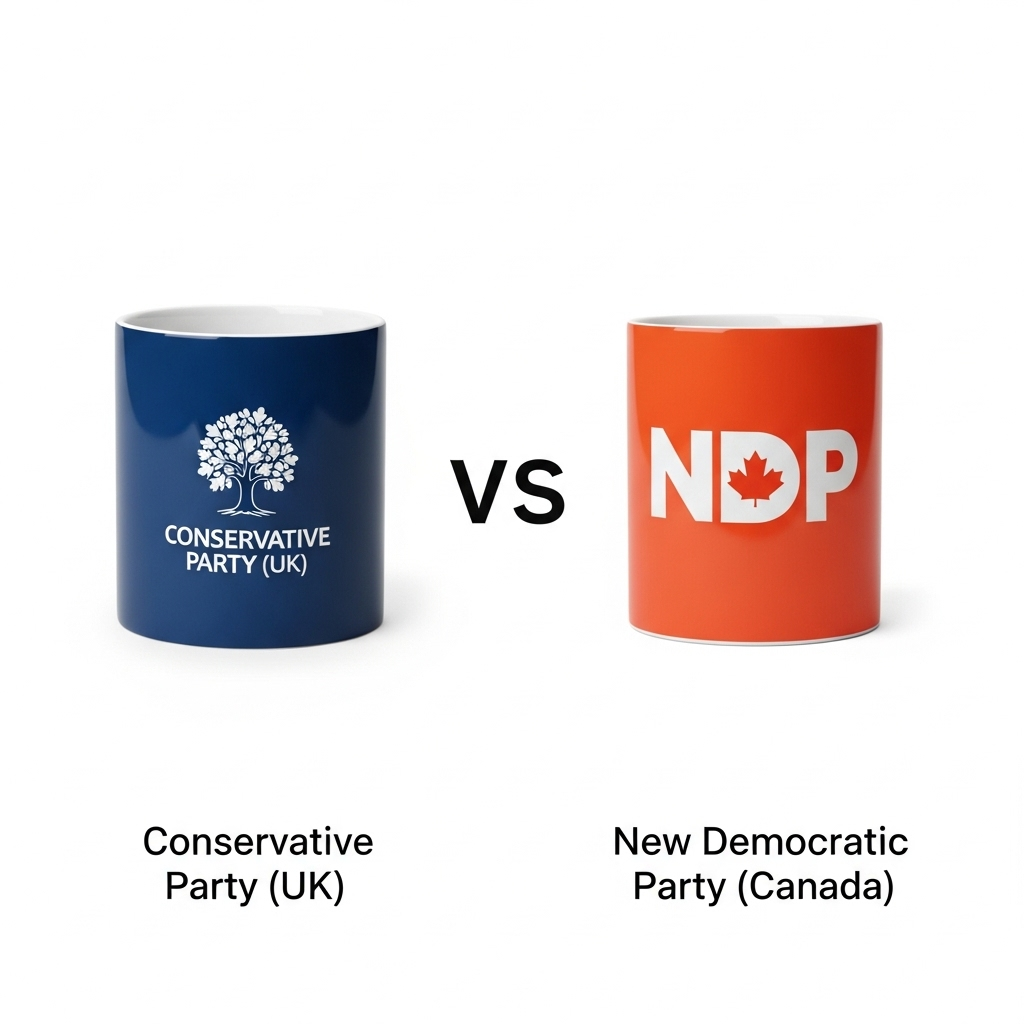Political parties: Conservative Party (UK) vs. New Democratic Party (Canada)
Quick Verdict
The Conservative Party (UK) and the New Democratic Party (Canada) represent distinct ideological positions and have experienced varying degrees of electoral success. The Conservatives prioritize economic liberalism, while the NDP focuses on social programs and environmental issues. Both parties have faced recent electoral challenges, highlighting the dynamic nature of their respective political landscapes.
- The Conservative Party (UK) is a centre-right to right-wing party with a history of electoral success, while the New Democratic Party (Canada) is a social democratic, centre-left to left-wing party.
- Both parties have experienced electoral setbacks recently, with the Conservatives losing a significant number of seats in 2024 and the NDP losing official party status in 2025.
- The Conservative Party focuses on economic liberalism and low taxes, while the NDP prioritizes social programs, universal healthcare, and climate change.
- Both parties have a substantial membership base, with the Conservatives having 123,000 members and the NDP having 124,620 members (as of 2017).
- The Conservative Party's support base is concentrated in rural and suburban areas, while the NDP's support base is historically among farmers and urban workers.

Key features – Side-by-Side
| Attribute | Conservative Party (UK) | New Democratic Party (Canada) |
|---|---|---|
| Ideology | Centre-right to right-wing, encompassing one-nation conservatives, Thatcherites, and traditionalist conservatives. Favors free markets and opposes government controls. British unionist. | Social democratic, centre-left to left-wing, democratic socialist faction |
| Electoral Performance | 121 seats in 2024 (lowest since 1832), 24% vote share (lowest since 1832). 365 seats in 2019. | 2011: 103 seats (Official Opposition), 2019: 24 seats, 2021: 25 seats, 2025: 7 seats (lost official party status) |
| Leadership | Kemi Badenoch (elected November 2, 2024) | Current interim leader: Don Davies, Former leader: Jagmeet Singh (resigned in 2025), Key figure: Jack Layton |
| Policy Positions (Economy) | Liberal economic policies, low taxes. | Mixed economy, broader welfare programs |
| Policy Positions (Healthcare) | Increase NHS spending, build/modernize 250 GP surgeries, build 50 Community Diagnostic Centres. | Universal healthcare, pharmacare, dental care |
| Policy Positions (Environment) | Previously committed to net-zero by 2050, but commitment dropped by Kemi Badenoch. | Cutting emissions, energy-efficient upgrades, retrofitting buildings |
| Membership Size | 123,000 members in July 2025 | 124,620 members in 2017 |
| Funding Sources | Membership subscriptions, local and national events. | Individual donations |
| Historical Performance | Founded in 1834. One of the two dominant political parties in the 19th century. Dominated British politics throughout the 20th century. | Official Opposition from 2011 to 2015, influenced policy in minority governments, formed governments in provinces |
| Internal Party Structure | The Board is the ultimate decision-making body. The leader is elected by the entire party membership. | Integrated federal and provincial NDPs with shared membership, democratic principles |
| Relationship with Other Parties | Merged with Liberal Unionist Party in 1912 to form the Conservative and Unionist Party. | Worked with the Liberal Party in confidence and supply agreements |
| Support Base | Concentrated in nonindustrial rural and suburban areas, especially in the south of England. In 2019, showed preference across all social classes, with more working-class voters supporting the Conservative Party than the Labour Party. | Historically farmers in Manitoba and Saskatchewan, urban workers in British Columbia and Ontario |
| Party Platform | Economy, taxes, welfare, expanding free childcare, education, healthcare, environment, energy, transport, and crime. | Healthcare, housing affordability, tackling climate change |
Overall Comparison
Conservative Party (UK): 121 seats in 2024, 24% vote share. New Democratic Party (Canada): 7 seats in 2025 (lost official party status).
Pros and Cons
Conservative Party (UK)
Pros:
- Historically electorally successful
- Advocates for free markets
- Pledges to increase NHS spending
- Focus on economic issues
Cons:
- Experienced a significant defeat in the 2024 general election
- Dropped commitment to net-zero carbon emissions by 2050
- Support base is concentrated in specific geographic areas
New Democratic Party (Canada)
Pros:
- Advocates for social programs and workers' rights
- Focuses on healthcare, housing affordability, and climate change
- Supports universal healthcare, including pharmacare and dental care
- Aims for sustainable prosperity and fair distribution of benefits
- Emphasizes skills training and research
- Historically influenced policy in minority governments
- Engages with members and the public through various channels
Cons:
- Experienced a significant decline in the 2025 election, losing seats and official party status
- Has never formed a federal government
- Fluctuating election results after the 2011 breakthrough
User Experiences and Feedback
Conservative Party (UK)
What Users Love
- No highlights reported.
Common Complaints
- No major complaints reported.
Value Perception
- No value feedback reported.
New Democratic Party (Canada)
What Users Love
- Emphasis on social justice and equality
- Commitment to government intervention to address societal needs
- Proposals often include expanding healthcare, affordable housing, and environmental initiatives
- Pledged to raise the basic personal income amount exempt from taxes and remove the GST from essentials
- Supports ending the consumer carbon tax while keeping industrial carbon pricing
Common Complaints
- Significant decline in the 2025 election
- Fluctuating election results after the 2011 breakthrough
Value Perception
- Focuses on building core Canadian values
- Advocates for policies aimed at supporting various demographic groups